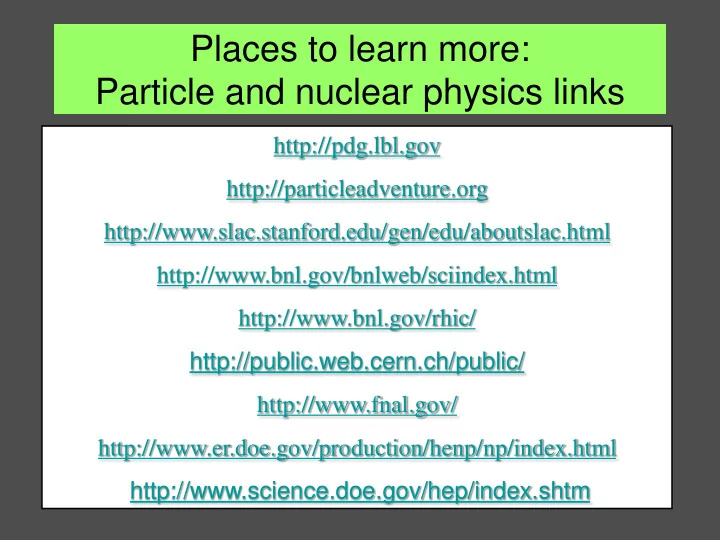

Places to learn more: Particle and nuclear physics links http://pdg.lbl.gov http://particleadventure.org http://www.slac.stanford.edu/gen/edu/aboutslac.html http://www.bnl.gov/bnlweb/sciindex.html http://www.bnl.gov/rhic/ http://public.web.cern.ch/public/ http://www.fnal.gov/ http://www.er.doe.gov/production/henp/np/index.html http://www.science.doe.gov/hep/index.shtm
Inquiring minds want to know ... Yo! What holds it together?
Fermi National Accelerator Laboratory (near Chicago)
CDF Minos
Stanford Linear Accelerator Center
Event display from the SLD experiment at SLAC
What forces exist in nature? What is a force? How do they interact? How do forces change with energy or temperature? How has the universe evolved?
Mini-Ph.D. – Quantum Mechanics 101 Lesson 1: Size actually does matter.
Determine the postion and velocity of a car … no problem
Determine the postion and velocity of a small particle … no problem
Cannot have Problem! perfect Heisenberg knowledge of uncertainty both the position and velocity principle Heisenberg
The fundamental nature of forces: virtual particles E t h Heisenberg E = mc 2 Einstein e -
17
Force Source Range Strength 10 -39 Gravitation mass infinite 10 -2 Electromagnetism Electric infinite charge 10 -15 m Strong nuclear Color 1 charge 10 -18 m 10 -5 Weak nuclear Weak charge
19
20
21
22
23
24
leptons quarks Gauge bosons e u c t e W, Z, g, G g e d s b Strong interaction Hadrons Baryons qqq qq mesons p = uud K = us or us = ud or ud n = udd nuclei atoms Electromagnetic interaction
Quantum Chromodynamics QCD strength relative Why bare quarks have asymptotic never been observed. freedom distance energy density, temperature quark-antiquark pair created from vacuum quark “white” 0 Strong color field E=mc 2 ! “white” proton “white” proton Energy grows with separation !!! (confined quarks) (confined quarks) 26 Thanks to Mike Lisa (OSU) for parts of this animation
27
28
qq e + e - e + e - e + e - e + e - e + e - qq e + e - qq qq -R. Kolb Much ado about NOTHING: qq qq qq qq e + e - qq Nothing is something qq qq Nothing has energy e + e - e + e - e + e - e + e - e + e - e + e - Nothing interacts with something e + e - qq e + e - qq qq qq qq qq 29
Kibble, Guralnik, Hagen, Englert, Brout 1
2
3
4
Modern accelerators study processes at energies that existed VERY early in the universe existed VERY early in the universe A Another form of time travel ! th f f ti t l ! What were forces like at those temperatures? What types of particles existed? What types of particles existed? 6
Recommend
More recommend